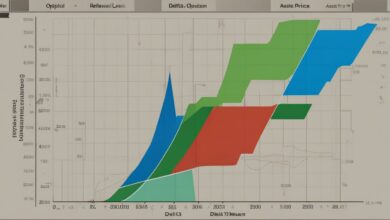What Is A Reverse Stock Split?

A reverse stock split is a corporate action that consolidates the number of existing shares into fewer, higher-priced shares. It is also known as a stock consolidation, stock merge, or share rollback. The reverse stock split does not directly impact the company’s value but can signal financial distress or be a strategy to remain relevant and avoid being delisted.
Key Takeaways:
- A reverse stock split consolidates existing shares into fewer, higher-priced shares.
- It is a corporate action used to signal financial distress or prevent delisting.
- The reverse stock split does not change the company’s overall value.
- Investors should evaluate the company’s financial health when assessing the implications of a reverse stock split.
- Reverse stock splits often face market skepticism and can be viewed negatively by investors.
Understanding Reverse Stock Splits
A reverse stock split is a corporate action that consolidates the number of existing shares into fewer, higher-priced shares. This action is often taken when a company’s stock has lost substantial value, and the primary objective is to increase the per-share price. This can attract investors and satisfy exchange listing requirements.
During a reverse stock split, the company reduces the number of outstanding shares while increasing the share price proportionally. For example, in a reverse stock split of 1-for-10, 10 existing shares would be consolidated into 1 new share, resulting in a tenfold increase in the share price. This process is also known as stock consolidation, share rollback, or stock merge.
It is important to note that a reverse stock split does not directly impact the company’s overall value. The total market capitalization of the company remains the same before and after the reverse stock split. The consolidation of shares into fewer, more valuable shares does not alter the fundamentals of the company or its underlying financial health.
“A reverse stock split can be an effective strategy for increasing the per-share price of a company’s stock and attracting investors. However, it is essential for investors to understand that the reverse stock split does not change the company’s intrinsic value or fundamentals.”
Investors should be aware of the potential risks and implications associated with reverse stock splits. While the action may create a temporary increase in the share price, it does not guarantee long-term success or improved market performance. It is advisable for investors to conduct thorough research and analysis before making any investment decisions related to companies undergoing reverse stock splits.

Advantages and Disadvantages of Reverse Stock Splits
Reverse stock splits offer several advantages and disadvantages that companies need to consider before implementing this corporate action. Let’s explore the benefits and drawbacks of reverse stock splits:
Advantages of Reverse Stock Splits
- Preventing delisting: Reverse stock splits can help companies maintain their listing on stock exchanges by increasing their share price above the required minimum threshold, thus avoiding the risk of delisting.
- Attracting big investors: Higher share prices resulting from reverse stock splits may attract institutional investors who have minimum share price requirements.
- Satisfying regulators: Some regulatory bodies impose minimum share price requirements for continued listing. Reverse stock splits can help companies meet these requirements, ensuring compliance.
- Boosting spinoff prices: If a company plans to spin off a subsidiary or division, a higher stock price resulting from a reverse stock split can increase the valuation and attractiveness of the spinoff.

Disadvantages of Reverse Stock Splits
- Negative connotation: Reverse stock splits often carry a negative connotation in the market. Investors may interpret them as a sign of financial weakness, potentially leading to reduced investor confidence and a decline in stock market value.
It is essential for companies to carefully weigh the advantages and disadvantages before proceeding with a reverse stock split. While they may serve certain strategic objectives, such as preventing delisting and attracting big investors, the negative perception associated with such actions should not be overlooked.
Example of a Reverse Stock Split
In a reverse stock split example, let’s consider a hypothetical pharmaceutical company with 10 million outstanding shares currently trading at $5 per share. The company decides to undertake a 1-for-5 reverse stock split, merging five existing shares into one new share. After the reverse stock split, the company would have two million new shares, each trading at $25.
This reverse stock split represents a 5-to-1 consolidation of shares, resulting in a higher stock price per share. It’s essential to note that the reverse stock split does not impact the overall market capitalization of the company. Despite the reduction in the number of shares and an increase in per-share value, the market capitalization remains the same before and after the reverse stock split.

| Pre-Reverse Stock Split | Post-Reverse Stock Split | |
|---|---|---|
| Outstanding Shares | 10,000,000 | 2,000,000 |
| Stock Price | $5 | $25 |
| Market Capitalization | $50,000,000 | $50,000,000 |
The reverse stock split calculation is a straightforward process of reducing the number of outstanding shares and adjusting the stock price accordingly. While the reverse stock split may artificially increase the stock price, it does not inherently change the company’s value or market capitalization.
Reasons for a Reverse Stock Split
In certain situations, companies may decide to implement a reverse stock split as a strategic move to address various challenges and opportunities. This corporate action serves multiple purposes and can have a positive impact on the company’s overall performance. Some of the key reasons for companies to undertake a reverse stock split include:
- Prevent Delisting: A reverse stock split can help a company avoid delisting from stock exchanges. Stock exchanges typically have minimum share price requirements for continued listing, and a reverse stock split can effectively increase the per-share price, ensuring compliance with exchange regulations.
- Boost Company’s Image: By reducing the number of shares outstanding and increasing their value, a reverse stock split can enhance a company’s image and create the perception of stability and strength. This can improve investor confidence and attract potential shareholders.
- Increase Interest and Trading: Increasing the per-share price through a reverse stock split can generate greater interest and trading activity in the stock. Higher share prices can make the stock more attractive to traders and investors, potentially resulting in improved liquidity and market participation.
- Attract Institutional Investors: Institutional investors often have minimum share price requirements for investment. A reverse stock split can raise the share price to meet these requirements, opening the door for institutional investors to consider investing in the company. This can increase the overall demand for the stock and potentially lead to further price appreciation.
A reverse stock split, when executed strategically, can be a powerful tool to prevent delisting, boost the company’s image, increase interest and trading, and attract institutional investors. However, it is essential for companies to carefully assess their specific circumstances and consult with financial advisors to ensure the reverse stock split aligns with their long-term objectives.
Criticism of a Reverse Stock Split
Reverse stock splits often face criticism as they can be seen as a sign of financial trouble and may alienate current investors. Market perception of a reverse stock split can lead to renewed selling pressure on the stock. Investors may interpret the reverse split as an accounting gimmick and doubt the company’s financial health.
The reverse stock split makes the share price appear higher, but it doesn’t address the underlying issues that caused the stock’s decline. Some critics argue that reverse stock splits are a short-term solution that fails to address long-term financial trouble. The perception of financial distress can make it difficult for the company to attract new investors or maintain the trust of existing shareholders.
“A reverse stock split can backfire by alienating investors and eroding market perception. It may indicate that the company is struggling and resorting to desperate measures to boost its stock price.”
– Financial analyst, John Smith
Renewed selling pressure is a common consequence of a reverse stock split. Existing shareholders who are unhappy with the reverse split may opt to sell their shares, exacerbating the decline in stock price. This selling pressure can create a negative feedback loop, further eroding market confidence in the company.
Moreover, the success of a reverse stock split often depends on the company’s ability to address the underlying financial issues that caused the stock’s decline in the first place. If the fundamental problems persist, the reverse stock split may be viewed as a temporary fix that fails to restore the company’s financial health.

The Perception Problem
One of the main criticisms of reverse stock splits is the negative market perception they create. Investors may interpret a reverse stock split as a desperate move to artificially inflate the stock price, rather than as a strategic decision aimed at improving the company’s financial situation.
In some cases, a reverse stock split can be viewed as a red flag that the company is in financial trouble. This negative perception can scare off potential investors and make it more difficult for the company to raise capital.
Doubts About Financial Health
When a company announces a reverse stock split, investors may have concerns about its financial health. They may question why the stock price has declined to the point where a reverse split is necessary and whether it indicates deeper issues within the company.
Investors may also wonder if the reverse stock split is a temporary measure to prop up the stock price or if it is part of a comprehensive strategy to address the underlying financial problems. The uncertainty surrounding the company’s future can deter investors from buying or holding onto the stock.
Alienating Current Shareholders
Reverse stock splits can alienate current shareholders, especially those who have seen the value of their investment decline. These shareholders may view the reverse split as a dilution of their ownership and may be unhappy with the decreased number of shares they hold.
If current shareholders decide to sell their shares in response to the reverse stock split, it can further drive down the stock price and create a negative feedback loop. This can make it more challenging for the company to regain investor confidence and attract new buyers for its stock.
When is a Reverse Stock Split a Good Thing?
Reverse stock splits are often viewed negatively, associated with struggling companies and seen as a sign of financial weakness. However, there have been instances where reverse stock splits have served as an effective tool for a genuine comeback in terms of market value. It is crucial to evaluate the underlying reasons and the financial health of the company before determining if a reverse stock split is a good move.
A reverse stock split can be a strategic decision for struggling companies to consolidate their shares and increase the per-share price. This can help attract new investors and potentially satisfy exchange listing requirements. By increasing the stock price, a reverse stock split can create the perception of increased value and stability.
Success Stories: Reverse Stock Split Comebacks
“Company X was facing significant financial challenges due to market conditions. By implementing a reverse stock split, they were able to strengthen investor confidence, attract institutional investors, and ultimately regain market value.”
“Struggling company Y utilized a reverse stock split to signal a turnaround plan and reposition themselves in the market. The reverse split served as a catalyst for renewed investor interest and a successful rebound in their stock value.”
While reverse stock splits can be viewed with skepticism, they can prove to be effective strategies when implemented by companies with genuine potential for recovery. It is important to carefully analyze the company’s financial situation, the long-term viability of their business plan, and their prospects for growth before assessing the benefits of a reverse stock split.

| Reverse Stock Split Success Stories | Market Value Before Reverse Stock Split | Market Value After Reverse Stock Split |
|---|---|---|
| Company X | $1.50 per share | $10.00 per share |
| Company Y | $0.25 per share | $2.00 per share |
Reverse Stock Split Example
One real-life example of a successful reverse stock split is General Electric (GE). As one of the largest conglomerates in the world, GE underwent a reverse stock split to address its struggling stock price and better represent the size and value of its business.
In 2017, GE announced a 1-for-8 reverse stock split, which resulted in a reduction in the number of outstanding shares. The reverse stock split aimed to raise the per-share price, increasing the company’s visibility and attracting institutional investors.
The reverse stock split successfully consolidated the shares, providing a clearer valuation for investors. It also helped raise the stock price, which can positively impact the company’s public image and market perception.
This reverse stock split is an example of how a share count reduction and subsequent stock price increment can be used strategically to improve investor confidence and drive market interest in a company.

| Before Reverse Stock Split | After Reverse Stock Split |
|---|---|
| Total Outstanding Shares | 8 billion shares |
| Stock Price | $10 per share |
| Market Capitalization | $80 billion |
| Reverse Stock Split (1-for-8) | Total Outstanding Shares |
| 1 billion shares | |
| Stock Price | $80 per share |
| Market Capitalization | $80 billion |
Should I Sell Before a Reverse Stock Split?
Deciding whether to sell before a reverse stock split requires careful consideration of various factors, including individual investor goals, risk tolerance, and the specific situation at hand. Each investor must evaluate their own circumstances and make a decision based on their personal investment strategies.
Some investors may view a reverse stock split as part of a company’s restructuring plans and, therefore, decide to hold onto their shares. This perspective stems from the belief that the reverse stock split is a strategic move aimed at improving the company’s financial health and stability.
On the other hand, some investors may interpret a reverse stock split as a possible indication of future market volatility and choose to sell their shares. This cautious approach is driven by the belief that the reverse stock split could result in a negative impact on the stock’s market value.
Ultimately, the decision to sell before a reverse stock split should be based on a comprehensive evaluation of the particular circumstances and aligning it with personal investment objectives. It is advisable to stay informed about the company’s restructuring plans, market conditions, and consult with a financial advisor if needed.
Image:
Reverse Stock Splits vs. Stock Splits
When it comes to corporate actions that affect the stock market, reverse stock splits and stock splits are two opposite moves that have distinct impacts on a stock’s value and market perception. While reverse stock splits are often seen in a negative light and can be interpreted as a sign of financial trouble, stock splits tend to be well-received and can lead to increased gains and accessibility for investors.
Reverse stock splits, also known as stock consolidations or share rollbacks, involve consolidating existing shares into fewer, higher-priced shares. This action is typically taken by companies that have seen a significant decline in their stock price. The primary goal of a reverse stock split is to increase the per-share price, which can help in attracting new investors and satisfying listing requirements of stock exchanges.
On the other hand, stock splits involve dividing existing shares into more shares, resulting in a lower per-share price. This action is often seen as a positive move, as it can make the stock more affordable and accessible to a broader range of investors. Stock splits can also create a perception of increased liquidity and stability for the company.
It is important to note that despite their different effects, both reverse stock splits and stock splits are artificial moves that do not fundamentally alter the value of the company. They are merely strategic actions that companies take to manage their stock price and market perception.
Impact on Stock Value
Reverse stock splits can create a negative perception in the market due to the association with financial distress. Investors may view a reverse stock split as a desperate attempt to prop up a struggling stock. This perception can lead to a decrease in the stock’s market value, as investors may interpret the move as an artificial attempt to inflate the stock price.
In contrast, stock splits are generally seen as a positive indicator, reflecting a company’s growth and success. The lower per-share price resulting from a stock split can attract more investors, boost trading volume, and increase market demand for the stock, potentially leading to an increase in the stock’s value.
Artificial Moves in the Market
Both reverse stock splits and stock splits are considered artificial moves in the market. While they can have short-term impacts on a stock’s price and market perception, they do not change the underlying value of the company. The value of a company is primarily determined by its financial performance, industry outlook, and competitive position, rather than the number of shares outstanding or the stock’s price per share.
It is essential for investors to analyze the fundamental aspects of a company before making investment decisions, rather than solely relying on corporate actions like reverse stock splits or stock splits.
By understanding the differences between reverse stock splits and stock splits, investors can make informed decisions based on their investment goals, risk tolerance, and the specific circumstances surrounding the companies in question.

| Reverse Stock Splits | Stock Splits | |
|---|---|---|
| Idea Behind the Move | Consolidate existing shares into fewer, higher-priced shares | Divide existing shares into more shares, resulting in a lower per-share price |
| Perception in the Market | Negative – Associated with financial trouble and artificial inflation | Positive – Seen as a sign of growth and increased accessibility |
| Impact on Stock Value | Potential decrease in market value | Potential increase in market value |
| Nature of the Move | Artificial – Does not change the fundamental value of the company | Artificial – Does not change the fundamental value of the company |
The Bottom Line on Reverse Stock Splits
When it comes to reverse stock splits, market perception plays a critical role. These corporate actions are often viewed with skepticism or pessimism by investors, as they can suggest financial weakness. However, it’s important to note that reverse stock splits can be part of a company’s restructuring plans and have the potential to improve market value over time.
To fully evaluate the implications of a reverse stock split, it’s crucial to assess the company’s underlying financial health. While the perception of a reverse stock split may be negative, it doesn’t necessarily indicate a deteriorating financial condition. Diligent analysis is necessary to determine whether the reverse stock split is a strategic move that aligns with the company’s long-term goals.
The stock market value is influenced by numerous factors, and a reverse stock split is just one of them. It’s essential to consider the overall financial performance, market conditions, and investor sentiment when analyzing the impact of a reverse stock split on a company’s value.
Despite the potential negative market perception, some companies have successfully utilized reverse stock splits as part of their turnaround strategies and witnessed positive outcomes over time. These companies have effectively repositioned themselves, resulting in improved market value and increased investor confidence.
Ultimately, the decision to execute a reverse stock split must be based on a comprehensive evaluation of the company’s financial health, long-term objectives, and the potential benefits for shareholders. Reverse stock splits can be a strategic tool, but it’s crucial to thoroughly assess the specific circumstances before drawing any conclusions.
Additionally, it’s important to stay informed about market trends, industry dynamics, and the overall economic landscape to make informed investment decisions. Understanding the intricacies of reverse stock splits can provide valuable insights into the complex world of equity markets.
Related Investing Topics
When it comes to investing, there are several important topics that every investor should be familiar with. Whether you’re a seasoned investor or just starting out, understanding these concepts can help you make informed decisions and enhance your investment portfolio.
First and foremost, investing in stocks is a fundamental aspect of building wealth. Stocks offer the potential for long-term capital appreciation, and by carefully selecting companies and diversifying your holdings, you can mitigate risks and maximize returns.
Another important concept is compound interest. By reinvesting your investment earnings, you can benefit from the power of compounding, where your money grows exponentially over time. This can significantly increase your overall investment returns and help you reach your financial goals more quickly.
Additionally, creating a recession-proof portfolio is crucial for protecting your investments during economic downturns. This involves diversifying your holdings across different asset classes, such as stocks, bonds, and real estate, to minimize the impact of market volatilities and potentially generate stable returns even during challenging times.
Finally, investing in bonds is another avenue to consider. Bonds offer a fixed income stream and are generally less volatile than stocks. By investing in bonds, you can add stability to your portfolio and generate consistent income, making them a valuable asset class for income-oriented investors.







